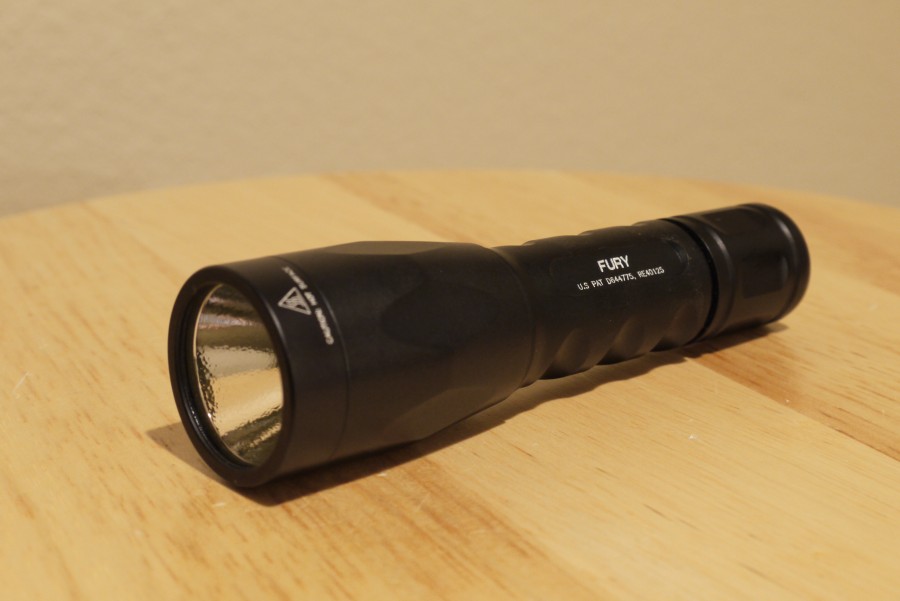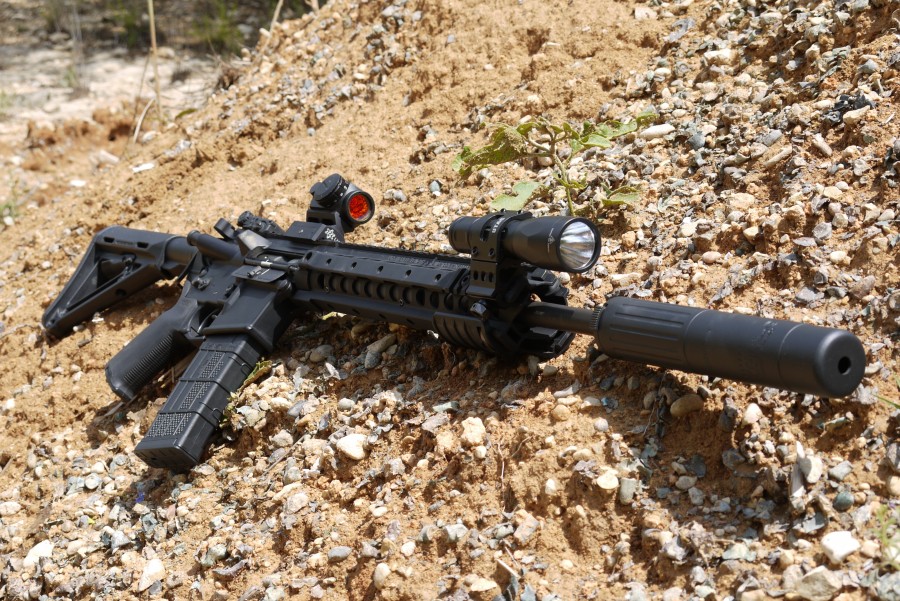In the run-up to the Crimson Trace Midnight 3-Gun, I came to the realization that I needed more light on my rifle than my TLR-1 could provide. I was going to be shooting at targets 50 to 100 yards away in the pitch black of an Oregon night, and 160 lumens wasn’t cutting the mustard. And when I think “flashlight” the first thing that usually comes to mind is “Surefire.” After a few minutes of browsing I came across the Fury, and 2 business days later it was on my gun.
When I’m on duty on the ambulance, I always carry my Surefire E2D LED Defender. I scammed Surefire out of it years ago and it has worked flawlessly ever since. The dual output gave me the ability to light up an accident scene with the “high” setting and then switch to the “low” setting to check patients’ pupils without blinding them. Plus the strike bezel has come in handy more than once for an, ahem, “expedient extrication” from motor vehicles. And despite the wear and tear and beating the crap out of it, the thing still works. Which is why “flashlight” = “Surefire” in my mind, and I was expecting the same kind of performance from the Fury.
When it arrived, the very first thing I noticed was that the settings were reversed. On the Defender, it defaults to “high” and then a quick powercycle brings it to the “low” setting. With the Fury, the low setting comes first and for good reason: the “high” setting is blindingly bright. It easily lights up my entire living room as if it were broad daylight — then again, my living room is tiny.
The Fury is about the same length as my old flashlight, which means its small enough to fit in a pocket. But the bell around the LED is MASSIVE by comparison, and when you realize that this thing is putting out 500 lumens of light you understand why. Even though the bell is much larger, it still mounts easily to a firearm. And despite the slightly larger size, it doesn’t seem to have gained much weight compared to the Defender — it clocks in at a svelte 5.7 ounces.
The body is a standard 1 inch tube, meaning any mounting option you want is pretty easily accomplished. Anything from re-purposed scope rings to special built mounts (like this one) works just fine keeping the light attached to your gat. And once mounted, turning it on and off via the tail switch is still a pretty simple procedure. If you’re not happy with the tailswitch you can even install a pressure strip that lets you activate the flashlight that way.
But how well does it actually work on a gun, in the dark? Well…
In that first video, the first round connects with a pepper popper about 50 yards away. The second video shows it lighting up an array of paper targets also 50 yards away.
So, in short, it works and it works REALLY well.
Care and feeding of the Fury is also pretty simple. It takes two CR123 batteries, which are now widely available at your local HEB or grocery store and pretty damn cheap. Which is good, because on full power it chugs through both of those in an hour and a half of continuous use. Low power gets you about two days worth of continuous light though, for those who don’t have massive stockpiles of batteries.
What you have here, then, is the perfect weapon light for your rifle. Its light enough to not throw off the balance of the gun, bright enough to positively ID targets out to the 100 yard mark (confirmed thanks to some testing with a 10 inch plate at Tyler’s ranch int he middle of the night), economical enough to be run continuously all night but with the ability to be just massively bright when you feel the need.
Surefire P2X Fury
Length: 5.40″
Output: 15 / 500 lumens
Runtime: 46 / 1.5 hours
Batteries: 2x CR123
Weight: 5.7 oz.
Price: $155 MSRP ($109 street)
Ratings (out of five):
Usability: * * * * *
Amazingly bright when you need it, but bright enough when you don’t.
Ergonomics: * * * *
By itself it just feels right in the hand, and in a mount on a rifle it works pretty well. A pressure switch in the box would have brought it up to a five star rating.
Accessories: * * * *
It doesn’t take ALL of the doo-dads that Surefire offer, and the 1.37″ bezel makes it difficult to find other aftermarket parts, but the 1″ tube lets it fit just about every flashlight mount out there.
Reliability: * * * * *
Its solidly built with a tough-as-nails finish.
Overall Rating: * * * * *
The best weapon light you can buy, for the money.






This is the light I wanted to get for my new Benelli M4.. figured it’d get a good review
Now I need a rifle worthy of this…
Will a pressure switch from a G2 fit this?
Anybody have any lights to recommend as far as handguns go? I have a full size M&P needing a proper flashlight, right now I have a 4sevens mini rigged up to it, and its bright, but not a dedicated tactical light per se.
I have a Streamlight TLR-1 on my M&P 9mm and it has been perfect during several thousand rounds through the pistol. It’s easy to actuate with the support hand thumb and they aren’t expensive. The lens gets dirty since the bell projects past the muzzle.
Was thinking of picking up the smaller TLR-3 since I don’t think the dimmer light will be all that horrible and the lower weight might be nice.
Seconding the TLR-1. Relatively cheap and good quality.
Crimson Trace makes something similar that comes with a laser as well. Seemed to work well for me.
Surefire X300 w/DG Switch. Supposed to be coming out this year with X300 ultra. 500 lumens.
“It takes two CR123 batteries, which are now widely available at your local HEB or grocery store and pretty damn cheap.”
Just be careful what you buy. Most of the CR123 batteries you’ll see at mass-market retailers (grocery stores, WalMart, etc) are sold as “camera batteries.” Read “cha-ching!” Anything with “camera” on it justifies even more of a markup than anything with “tactical” on it. My local grocery store sells both Duracells and Energizers labeled as “Li-ion Camera Batteries” in 2-packs for $11. You can buy batteries direct from SureFire in packs of 12 for $22.50 + $7 shipping. One of my local gun stores will sell me the SureFire 12 count box for $25.
Thanks for the review, Nick.
Hey Nick, what optic are you sporting on there?
Primary Arms MD-02 red dot.
http://230grain.com/showthread.php?67132-Is-my-optic-Ready-for-the-Tactical-Bathing-Environment-The-Primary-Arms-MD-02
Like $80 and just as good as an Aimpoint.
Actually, per this site, http://www.ehow.com/about_5385320_candlepower-vs-lumens.html, 1 candela = 12.57 lumens.
But who carries candelas these days?
It is a bit more complicated than that – one simply can’t convert from Lumens to Candlepower.
Candlepower is a point measurement of light. They shine a light against a surface, find the brightest spot and use the instrument to measure that one spot.
Lumen is the measurement of the *total* output of a light source. To measure it, you need a device called an integrating sphere – you shine the light in and it disburses across the interior of the sphere perfectly. Light is measured at a single point on the sphere, but that’s OK because the light is perfectly (or near perfectly) distributed. Little bit of math and you get a measurement of the total amount of light, irrespective of the shape of the beam.
This all gets complicated because there are all sorts of measures of light output. SureFire is the company that brought the idea of measuring light output to the market in “Lumens” because it is a far more honest measure than the amorphous “Candlepower” (a figure that can be manipulated with relative ease).
About 25 years ago, I had a machinist friend of mine make a custom mount for a 3 “C” cell Maglite for a AR-7 I own. Yeah, it’s big, it’s heavy, but it does light up the area. That was what was available at the time. I keep seeing these “little” flashlights and see that they are more and more affordable now a days, so I might have to upgrade.
1 Lumen does NOT equal 1 Candlepower does NOT equal 1 Candella.
There is such a thing as too much light. Strong lights are great for distance, but you may actually blind yourself with reflecting light at close quarters. The right balance is important
Lights with on/off clicks are not a good idea, as you need the ability to turn the light off instantly and pressing the button halfway for momentary use usually ends up with a click-on which you now have to click off. A momentary only switch with no clicks is the best option which makes most of the lights on the market useless.
Agree with Rab and would like to add, in my opinion, lights with more than one option on the switch are a bad idea. They have a tendency to get bumped while moving or under recoil you bump the switch and now you have 15 lumens instead of 500 and you’re messing with your light while you should be shooting. We learned this the hard way. I also watched several shooters struggle with the Fury’s switch on my stage at the CTC shoot.
It saids in the user manual by SF that this light is not recommended for weapon-mounting applications, but people so far seem to be doing that without problems.
Nick I’m curious, how do you daily carry the defender? It seems like carrying it in a pocket would be a literal pain with bezels on both ends.
Ben, I carry mine for work and I just clip it inside the front right pocket of my jeans. Actually very comfortable and haven’t noticed any obvious wear in the pocket from the bottom crennelation. It just sits there unnoticed on my hip.
Nick, what mount are you using on that AR?
Which tape switch would I need to buy to install on the fury?
I’ve been a Surefire user for years in various configurations, so I had no reservations about buying the Fury. Unfortunately, the endcap failed after about a year, and I got no response at all from product support. So, I’m currently a little sour on that particular product. Just my $0.02 worth, and as valuable as its price.
Comments are closed.